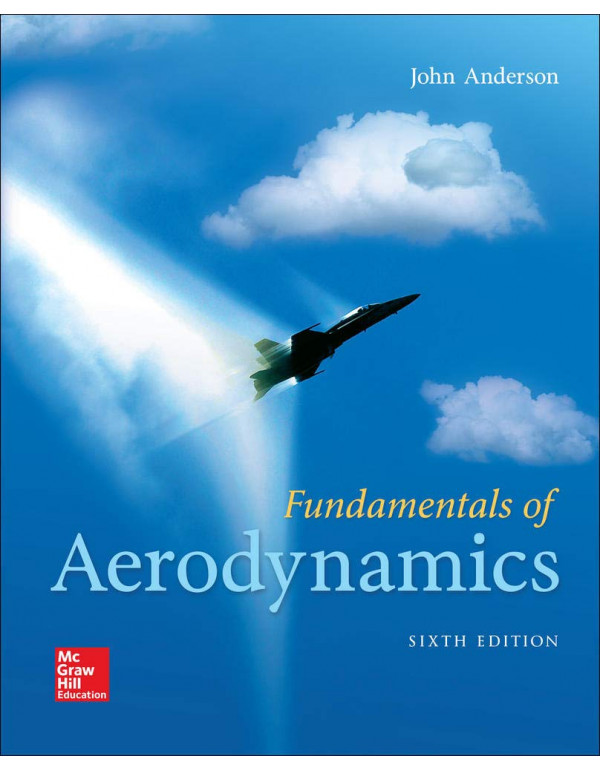Tags: Fundamentals Of Aerodynamics *US HARDCOVER* 6th Ed. By John Anderson - {9781259129919} {1259129918}
Fundamentals Of Aerodynamics *HARDCOVER* 6th Ed. By John Anderson - {9781259129919} {1259129918}
GBP109.99
Fundamentals of Aerodynamics, 6th Edition by John D. AndersonOverviewThis highly regarded textbook, Fundamentals of Aerodynamics, by John D. Anderson, serves as a cornerstone for understanding the principles of aerodynamics. Published in its sixth edition, the book offers a comprehensive and detaile..
- Type: Hardcover Book.
- Publisher: McGraw Hill; 6th edition (March 21, 2016)
Fundamentals of Aerodynamics, 6th Edition by John D. Anderson
Overview
This highly regarded textbook, Fundamentals of Aerodynamics, by John D. Anderson, serves as a cornerstone for understanding the principles of aerodynamics. Published in its sixth edition, the book offers a comprehensive and detailed explanation of aeronautical concepts, making it a valuable resource for students, engineers, and professionals in the field of aerospace engineering.
Key Themes
Fundamental concepts of fluid mechanics relevant to aeronautics
Applications of Bernoulli's equation and Navier-Stokes equations
Airfoil theory and wing design principles
Drag and lift forces acting on aircraft
Boundary layer theory and its impact on aerodynamic performance
Compressible flow and concepts of shock waves
Fundamentals of aircraft performance, stability, and control
Features
Employs a conversational writing style to make complex topics approachable for beginners.
Integrates historical background and anecdotes to add context and spark interest.
Provides learning objectives at the start of each chapter to guide student focus.
Includes numerous figures, diagrams, and problem sets to solidify understanding and encourage practical application.
Offers a solutions manual (available for purchase) for selected problems.
Target Audience
Aerospace engineering students at undergraduate and graduate levels
Practicing aeronautical engineers seeking a reference guide
Anyone interested in gaining a deeper understanding of the science of flight
Strengths
Clear and engaging writing style
Rich pedagogical tools for learning reinforcement
In-depth coverage of theoretical foundations and practical applications
Up-to-date content reflecting advancements in aeronautical science
Offers a solutions manual for self-study or instructor-led courses
Chapter Headlines (Examples may vary)
Introduction to Aerodynamics
Fundamental Concepts of Fluid Mechanics
Incompressible Inviscid Flow
Airfoils and Drag
Boundary Layer Theory
Incompressible Viscous Flow
Dimensional Analysis and Similitude
Compressible Flow
Fundamentals of Gasdynamics
Airfoil Theory for Compressible Flow
Drag in Compressible Flow
Fundamentals of Aircraft Performance
Aircraft Stability and Control
Wind Tunnels and Experimental Methods
Closing Paragraph
"Fundamentals of Aerodynamics" by John D. Anderson equips readers with a strong foundation in the theoretical and practical aspects of aerodynamics. Through its clear explanations, engaging style, and valuable learning aids, this book remains a classic resource for students and professionals in the field of aerospace engineering.
Overview
This highly regarded textbook, Fundamentals of Aerodynamics, by John D. Anderson, serves as a cornerstone for understanding the principles of aerodynamics. Published in its sixth edition, the book offers a comprehensive and detailed explanation of aeronautical concepts, making it a valuable resource for students, engineers, and professionals in the field of aerospace engineering.
Key Themes
Fundamental concepts of fluid mechanics relevant to aeronautics
Applications of Bernoulli's equation and Navier-Stokes equations
Airfoil theory and wing design principles
Drag and lift forces acting on aircraft
Boundary layer theory and its impact on aerodynamic performance
Compressible flow and concepts of shock waves
Fundamentals of aircraft performance, stability, and control
Features
Employs a conversational writing style to make complex topics approachable for beginners.
Integrates historical background and anecdotes to add context and spark interest.
Provides learning objectives at the start of each chapter to guide student focus.
Includes numerous figures, diagrams, and problem sets to solidify understanding and encourage practical application.
Offers a solutions manual (available for purchase) for selected problems.
Target Audience
Aerospace engineering students at undergraduate and graduate levels
Practicing aeronautical engineers seeking a reference guide
Anyone interested in gaining a deeper understanding of the science of flight
Strengths
Clear and engaging writing style
Rich pedagogical tools for learning reinforcement
In-depth coverage of theoretical foundations and practical applications
Up-to-date content reflecting advancements in aeronautical science
Offers a solutions manual for self-study or instructor-led courses
Chapter Headlines (Examples may vary)
Introduction to Aerodynamics
Fundamental Concepts of Fluid Mechanics
Incompressible Inviscid Flow
Airfoils and Drag
Boundary Layer Theory
Incompressible Viscous Flow
Dimensional Analysis and Similitude
Compressible Flow
Fundamentals of Gasdynamics
Airfoil Theory for Compressible Flow
Drag in Compressible Flow
Fundamentals of Aircraft Performance
Aircraft Stability and Control
Wind Tunnels and Experimental Methods
Closing Paragraph
"Fundamentals of Aerodynamics" by John D. Anderson equips readers with a strong foundation in the theoretical and practical aspects of aerodynamics. Through its clear explanations, engaging style, and valuable learning aids, this book remains a classic resource for students and professionals in the field of aerospace engineering.

